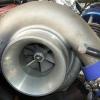What Should My Plug Gap Be?
Announcements
-
Similar Content
-
Latest Posts
-
Put another overflow bottle (ie, a 1.25 coke bottle or similar) under the overflow hose and see if it is being pushed out there or if it is disappearing into the engine.
-
Staring on a stand is no issue. You just have to wire everything up, give it fuel and cross your fingers that the stand is robust enough. Arranging the inlet plumbing is often the hardest part, without any surrounding structure to hand some of it from. No need for coolant if you only want to run it for <1 minute. As to the gearbox - I think the little Aisin box is a bit stronger than the other small Nissan boxes that went behind SRs, but I wouldn't be too keen to test its limits with the torque of a boosted 25. I don't know if you can retain the box and the tailshaft. The box won't connect to the RB without an adapter of some sort, which is either a plate that will push the engine forward (which is not good for fitting it into the bay's available space) or push the box back, which messes with the box position and tailshaft length - OR - cut and shut work on the bellhousing, which is a long way from "least modification". I'd be buying a new 370Z 6 speed or similar, doing what has to be done to that to make it fit RB (ie, cut and shut bellhousing) and the requisite tailshaft custom/mods.
-
Hi Everyone I am from West Pennant Hills in NSW. Been too busy until recently to attend to my RB25DET Series 2 engine until recently. I am planning to stick it into the S15 shell at this stage, unless a nice SR20DET turns up... For now, i am going to try and get the RB25 running and working well then decide what gearbox to use. My preference is to retain the SR20DET 6 speed gearbox and tail shaft to retain as much and least modifications as i can avoid. I am an old guy and won't be doing any heavy drifting so i don't need a bullet proof gearbox Does anyone have experience with starting the RB on a stand? I got everything setup as much as I can with the info i can find... endless searching and videos on Youtube I would be great to get some pointers Cheers Songo
-
Hey all, Recently have had my s1 r33 gtr serviced and noticed my coolant reservoir was topped up to the max line. Took the car out for 1 yesterday and noticed today the reservoir is completely empty. Any ideas? Radiator is full





Recommended Posts
Create an account or sign in to comment
You need to be a member in order to leave a comment
Create an account
Sign up for a new account in our community. It's easy!
Register a new accountSign in
Already have an account? Sign in here.
Sign In Now